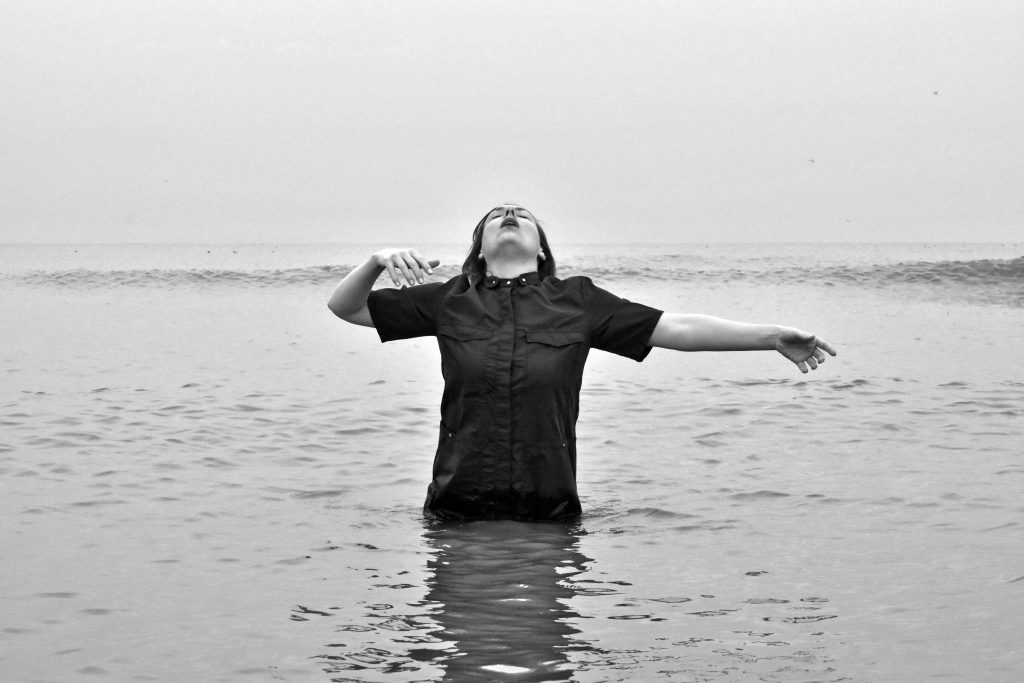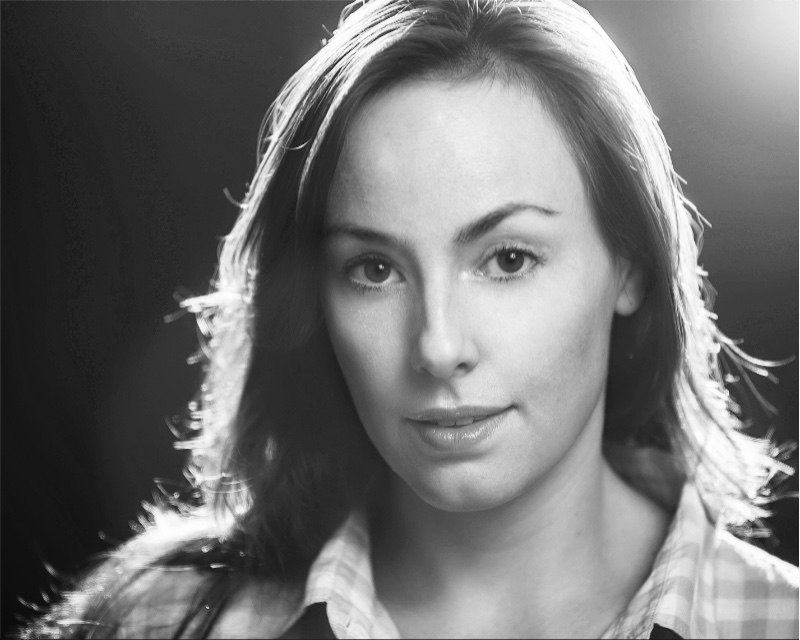Kate Hilliard is a Toronto-based artist and the Artistic Director of Granite Motion Gallery. What fascinates me about her work and …this happened, her new, contemporary piece at Compagnie + Citadel in Toronto, is how she combines different art forms: dance, poetry, and the visual arts. We chatted about her new show, how she hopes audiences will connect with it, and about her observations on arts education today.
Lori: Let’s start off with …this happened. It’s poetry and dance and that intrigued me right from the get go when I saw that. How did that come about?
Kate: A number of very personal things happen in my life and they were so monumental that my foundation of self was rocked… I no longer understood how to identify in the world. And so, I knew that I had to make a shift and I knew that I had to invest in my creative practice.
Lori: How do you work with that? It can be hard to step away from life and invest in creative practice.
Kate: I needed to do it far away from my own community and far away from the pressures of presenting work. So, I began an MFA in creative research at the Transart Institute, which is accredited through Plymouth University in the U.K.
Lori: How did your dance experience factor into this, then?
Kate: I had not been able to find a way of expressing the things that I had gone through in my movement alone. […] There’s a very strong statement that movement can say things that words can’t. And then I think also words can conceptually convey understandings that perhaps movement doesn’t do as well. So, I don’t ever use them to replace one another, but just to further a larger expression of ideas.
Lori: Can you explain your process of going from dance to words to dance more?
Kate: We use the movement in a very conversational way, in a very codified way in that we have interpreted words using movement. And the bodies behave onstage as if in movement conversations. We say words all of the time, but our bodies betray their meanings. And the slippage between things things is something that really interests me.
Lori: How does this all play out in your show?
Kate: It’s non-liner and quite episodic. The statement “this happened” is in reference to a number of personal chapters: raising two children, raising two children for a period of time alone after going through a very painful divorce, and losing my own father in the middle of all of that. And then also finding partnership once again. I was actually remarried this past summer.
Lori: Oh, congratulations! That’s a lot to deal with.
Kate: Thank you. It’s been a very big five years. I am a fairly—I think—emotionally even-keel person and a very pragmatic person. But I’m reflecting on my own history and I’m sideswiped by my journey.
Lori: I can imagine.
Kate: Then I’m fortunate because I have this incredible collaborative team of artists who have also lived through very deep and profound things through the five years that we’ve been working. And their content, life content, also inspires and informs this work. So, it’s not just my own personal diary that’s on stage by any sense. I think we’re looking at universal, relatable ideas concerning grief and concerning love and loss and moving forward. We all have moments when we feel like we’re free falling in life.
Lori: How do you hope that audiences will approach your work?
Kate: I hope that they’ll just approach it with no preconceptions about what they’re going to see. It is very much an interdisciplinary show. I hope that people will be carried away with the many layers of the work. I hope that people will be able to hang on, or anchor themselves in something that is said or something that they see. The performance is quite rich with visual imagery with very emotive and pointed sound.
Lori: Where do you think they might find that relation?
Kate: We can all understand what it means to see communication breakdown. We can all relate to what it feels like to be suspended in our lives, not knowing which way to go. We can recognize what it means to have memories that are sort of monuments in our world. And we refer back to these as points of major shifts, major change. So, I hope that people will be able to grab hold of that and to experience the piece as it pertains to their own subjectivities.

Lori: Yes, I can definitely see audiences grasping on to those tangents. Now, I’d like to switch over to arts education, because you also teach at various institutions. What do you feel about dance in arts education these days?
Kate: I’m an instructor at Ryerson University in the School of Performance within the dance department. So, I have the opportunity of seeing dance education as it prepares people to go into the dance industry. And I think that’s very specific as it pertains to the performing arts industry.
Lori: Absolutely. So how do you view dance for those who don’t plan a career in it?
Kate: I think moving in your body is something that brings joy. I think we live in a society in Canada and North America that is incredibly conservative as it relates to touch and feeling whole in our body. I think there’s an enormous amount of conflict around body judgment and unhealthy understandings that kids pick up because they are so bombarded by consumerism as it relates to body image.
Lori: I couldn’t agree with you more. How can we help that in our school system?
Kate: A really great movement practitioner, a really great workshop facilitator in public school systems, will use dance as a vehicle to get kids doing things that are so healthy, so rich, and they won’t even know that all of a sudden they have lost their inhibitions, that they’re doing things physically that they wouldn’t normally do. Now I’ll preface all of that by saying I don’t think the dance forms as we understand them—ballet, contemporary dance, tap—are necessarily the way of delivering that kind of education.
Lori: I’ll admit, after over 20 years studying codified forms, like tap, jazz, and ballet, I have a hard time picturing anything else.
Kate: I have a pretty long history of working in the public school system in dance with young students. I used to work for the Learning Through the Arts program through the Royal Conservatory, and I now am the director of education at the Orillia Centre for Arts and Culture. And when we program dance workshops, we’re thinking about movement practitioners, dancers, who use movement as a way of getting kids to shed their emotional armour.
Lori: For families who don’t have the budget for the extra classes, do you have any suggestions on what they can do to help foster the arts in their children?
Kate: We live in a technological world, so I am not a parent or an educator who feels that technology should be repressed. But that said, it’s amazing to watch what will happen to a child when you take away a screen. Left to their own devices and a pack of pencil crayons or some great music playing in the background, a whole bunch of cardboard boxes…children want to develop creatively. They say that one of the most important things you can be cultivating in a child for a healthy and successful future is their ability to be adaptable, their ability to be emotionally mature, and their ability to be empathic. Creativity is really the capacity to be able to think in many ways, right?
Lori: Which means anyone can do it at home.
Kate: I don’t think you need to send your children to expensive dance lessons in order for them to develop a love of music and movement. I think you need a library of music and I think you need a home that has a sound system setup so that music is playing. You need to be cultivating an environment in your family where there is no such thing as good and bad when it comes to dance moves. I think a lot of the time, very sadly, people enrol their kids in so many different activities that it becomes stressful. And we know that creativity is in fact hampered by stress. So, if your child is stressed out about going to piano lessons or dance lessons then maybe it’s not helping.
Lori: I agree with that. There’s a time and a place to encourage children to participate in more formal education, but often a lot can be encouraged at home. Thank you, Kate, for taking the time to talk with me.
Kate: Thank you.
Kate Hilliard’s latest piece, …this happened, opens at Citadel + Compagnie in Toronto on January 29th, 2020. You can order your tickets here.

We manage all data submitted as outlined in our privacy policy.